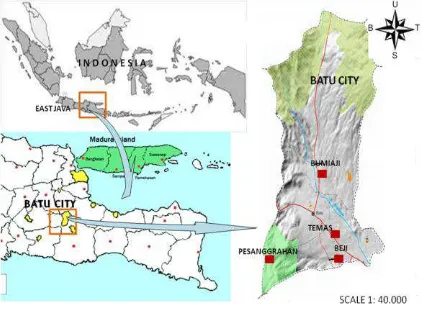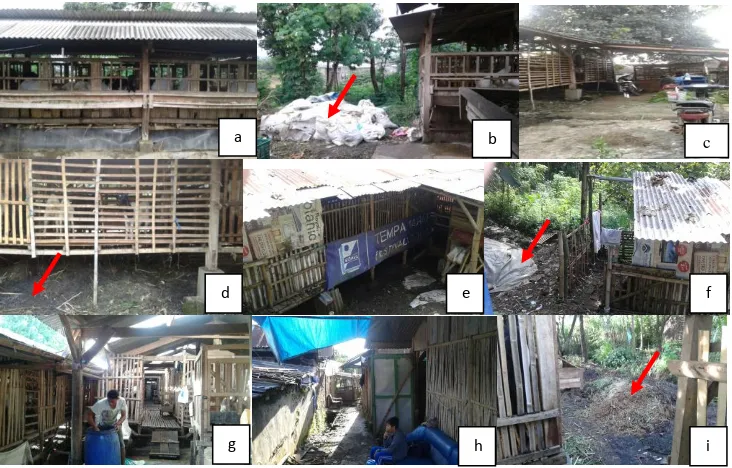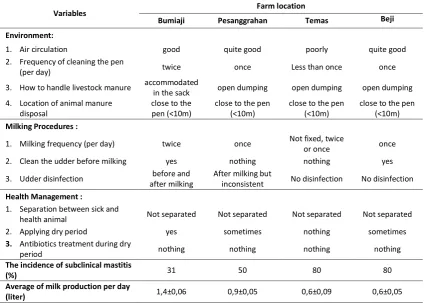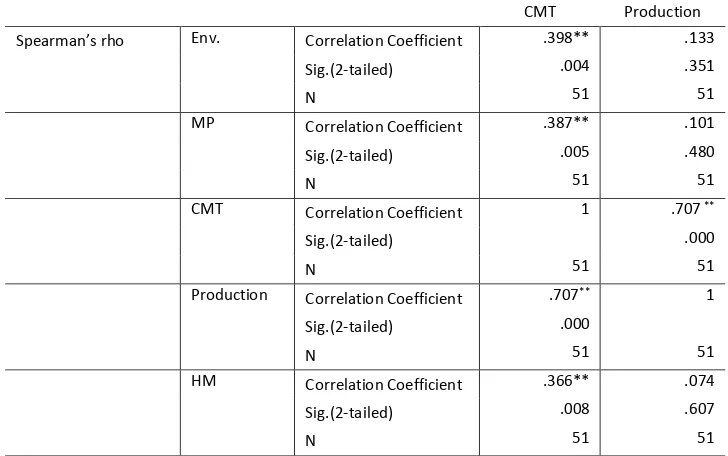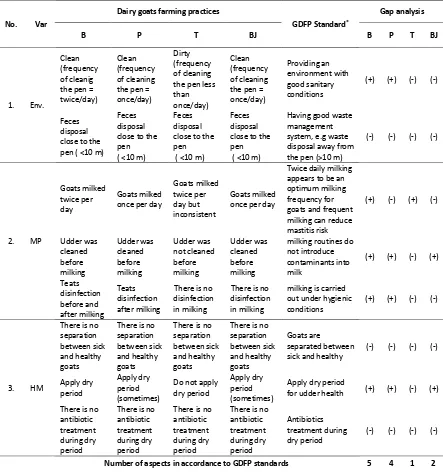163
Strategic Planing to Develop Good Dairy Farming Practices in Smallholder
Dairy Farms in Batu City, East Java
Reni Indarwati
1*, Herawati
2, Endang Arisoesilaningsih
31Master Program of Biology, University of Brawijaya, Malang, Indonesia 2Faculty of Veterinary Medicine, University of Brawijaya, Malang, Indonesia
3Department of Biology, University of Brawijaya, Malang, Indonesia
Abstract
Some of the objectives to be achieved in this research is to describe the attack profile of subclinical mastitis on Etawah Crossbreed Goats (ECG) in some smallholder farms, to identify risk factors that contribute to subclinical mastitis attacks and to compile a strategic plan to develop Good Dairy Farming Parctices (GDFP) in Batu. The data were gathered by interviewing smallholder farmer and direct observation in the three farms goats in Batu (Bumiaji, Pesanggrahan, Temas and Beji village). California Mastitis Test (CMT) is used to detect subclinical mastitis on 51 ECG lactation belonging to farmer. Risk factors Identification of subclinical mastitis conducted by Spearman correlation analysis. All of smallholder compared with GDFP concept using gap analysis. Meanwhile, the strategic development plan of GDFP in Batu was done by the Root Caused analysis. The results showed that 100% subclinical mastitis attacks occurred on three dairy goats farms in Batu City with the level 31-80% percentage of attacks. This subclinical mastitis attacks positively correlated with milk production (p <0.01). The risk factors of subclinical mastitis partly because of the environment (p<0.01), milking procedure (p <0.01) and health management (p <0.01) were not right. The strategic plan to develop GDFP in Batu City are Increase knowledge and awareness of farmers about how to implement good dairy farming practices on Etawah Crossbreed farm, particularly in the benefits of clean environmental, handling and using goat manure, the benefits of sanitation and disinfection of udder, the effect of milking frequency on udder health and the urgency of separation between healthy and sick goats.
Keywords: good dairy farming practices, risk factors, subclinical mastitis
INTRODUCTION
According to the data from Statistics Animal Husbandry and Animal Health Ministry of Agriculture in 2013, East Java Province is the largest producer of fresh milk in Indonesia from 2009 to 2012 [1]. One of the cities in East Java, which is a milk production center, is Batu City. In 2013, milk production in Batu City was 416,418,654 kg and goats milk as much as 4,573,135 kg. Goat milk production in Batu during the year showed an increase from the previous year. In 2012, the goat milk production was 392,184 kg [2]. This is because the public is increasingly aware that goat milk has many benefits, especially for human health and have better nutritional content than cow's milk, so the market demand for goat's milk increased [3,4,5,6].
However, market demand is not matched by the number of the existing milk production. Domestic milk production can only be accounted
Alamat Korespondensi Penulis:
Reni Indarwati
Email : [email protected]
Address : Master Program of Biology, University of Brawijaya, Jl. Veteran Malang 65145
164 production, to identify risk factors that
contribute to subclinical mastitis attacks, to know famers weakness in dairy farmning practices and compile a strategic plan to develop Good Dairy Farming Practices (GDFP) on smallholder dairy farms in Batu City.
MATERIALS AND METHODS
This research was carried out on three goat dairy farms scattered in three places in Batu, East Java, Indonesia, namely Bumiaji, Pesanggrahan, Temas and Beji village (Fig. 1.). The study was conducted in December 2014 to May 2015 using 51 Etawah Crossbreed Goats (ECG) those are being lactation as sample. A total of 35 goats belonging to farmers in Bumiaji village, 6 goats belonging to farmers in Pesanggrahan village, 5 goats belonging to farmers in Temas village and 5 goats belonging to farmers in Beji village.
Figure 1. Map of study sites in Batu City
Recording of milk production conducted for 14 days. To determine subclinical mastitis status, goats were tested by California Mastitis Test (CMT) [5]. CMT test conducted by mixing CMT reagents and goat milk samples with a ratio of 1:1, and then shake it slowly for ± 10 seconds. The interpretation of CMT test results are as follows: positive one (+1) is characterized by a slightly thickened mass, positive two (+2) is characterized by a more viscous consistency mass of positive one (+1) and positive three (+3) is characterized by a mass that resembles gelatin and difficult to move, goats tested positive for subclinical mastitis if the test results showed positive CMT 2 (+2) [11,15].
Risk factors identification is done by direct observation to the farm and famer interview using a semi-structured questionnaire. The data
are gathered include : environmental (pen sanitation, animal waste handling and air circulation), milking procedures (milking frequency, udder hygiene and milking sanitation) and health management (separation between sick and livestock healthy animals, dry period and antibiotics treatment during the dry period).
All data were tabulated in Microsoft Excel
2007, descriptively analyze. Spearman correlation analysis was performed to identify risk factors for subclinical mastitis attacks in the three smallholder farms. Gap analysis used to indentify the weaknesses in goat dairy farming practices, by comparing four dairy goat farms profile with Good Dairy Farming Practices concept according to some standard references and FAO ( Food and Agriculture Organization). Furthermore, root cause analysis used to develop some strategic planing of GDFP on smallholder farmers in Batu City.
RESULTS AND DISCUSSION
Subclinical mastitis test on 51 Etawah crosbreed goats using California Mastitis Test (CMT) is presented in Fig. 2A. and Fig. 2B. From these data, it appears that subclinical mastitis attacks occurred on three farms in Batu City. Goat dairy farm in Temas and Beji village has the largest percentage of subclinical mastitis incidence (80%), meanwhile Pesanggrahan village & Bumiaji village as much as 50% and 34%, respectively. Subclinical mastitis cases in Indonesia were reported in 2006 is still quite high, around 75-83% [10]. This is because the symptoms of subclinical mastitis attacks do not realize its presence by farmers, so farmers tend to ignore [12].
165
proliferation of bacteria [16,17,18], while the air circulation in Pesanggrahan and Beji village have adequate ventilation, but not quite optimal sunlight into the pen area. On the other hand,
goat pen belonging to farmers in Temas village, less air circulation for ventilation enclosure partially closed plastic and paper so that sunlight is not free to enter into the pen area (Fig. 3.).
35
12
23 6
3
3 5
4
1
5
4
1
0 10 20 30 40 50 60
number of goat
subclinical mastitis
negative
num
be
r
of
goa
t
Beji Temas Pesanggrahan Bumiaji
34
50
80 80
66
50
20 20
0 20 40 60 80 100 120
Bumi aji
Pesa nggra
han
Tema s
Beji
s
u
b
c
lin
ic
a
l
m
a
s
ti
ts
(
%
)
negative subclinical mastitis
Figure 2. Profile of subclinical mastitis attacks on four dairy goat farms in Batu City : A. Variation of goat population which are attacked subclinical mastitis, B. Goat percentage which are attacked subclinical mastitis
Figure 3. Goats pen Profile of three goat farms in Batu City: a-b) goat farm in Bumiaji Village; c-d) goat farm in Pesanggrahan Village; e-f) goat farm in Temas Village; g-h) goat farm in Beji Village. (the red arrow indicates the location of feces disposal)
a
f e
d
c
b
i h
g
166
Table 1. Etawah Crossbreed Goats farm profiles in Batu City
Variables
Farm location
Bumiaji Pesanggrahan Temas Beji
Environment:
1. Air circulation good quite good poorly quite good 2. Frequency of cleaning the pen
(per day) twice once Less than once once
3. How to handle livestock manure accommodated
in the sack open dumping open dumping open dumping 4. Location of animal manure
disposal
close to the pen (<10m)
close to the pen (<10m)
close to the pen (<10m)
close to the pen (<10m)
Milking Procedures :
1. Milking frequency (per day) twice once Not fixed, twice
or once once 2. Clean the udder before milking yes nothing nothing yes
3. Udder disinfection before and after milking
After milking but
inconsistent No disinfection No disinfection
Health Management :
1. Separation between sick and
health animal Not separated Not separated Not separated Not separated 2. Applying dry period yes sometimes nothing sometimes
3. Antibiotics treatment during dry
period nothing nothing nothing nothing
The incidence of subclinical mastitis
(%) 31 50 80 80
Average of milk production per day
(liter) 1,4±0,06 0,9±0,05 0,6±0,09 0,6±0,05
Environmental filthy pens have a greater risk of developing mastitis than clean environment [18,19,20]. The milk procedures that are done by farmers in Bumiaji village is better than the other farmers, namely consistency of the milking time, frequent in the milking frequency and do sanitation and disinfection before and after milking. Livestock are frequently milked and carried udder disinfection during milking will reduce the risk of subclinical mastitis [21,22,24,25]. Teat disinfection at the time before and after milking can reduce somatic cell counts and also the level of new intramammary infections [23,26].
In animal health management, all of farmers were not doing the separation between sick and healthy animals. The separation between sick and healthy animals will reduce the spread of disease in farm environment. The application of dry period consistently performed by farmers in Bumiaji village, while farmers in Pesanggrahan and Beji village were not consistently applies it. On the other hand, farmers in Temas village was not apply dry periode at all times. Dry period is done by cessation of milking frequency gradually through setting up milk secretion stops. Some benefits of the dry period are allowing time for rest and restore the function of mammary gland,
167
Gap analysis carried out between dairy farming practices on four goat farms (Bumiaji, Pesanggrahan,Temas and Beji village) and good dairy farming practices concept, according to some references and FAO (Table 3.). There are three aspects that is not in accordance to Good Dairy Farming Practices (GDFP) in Batu City, an aspect environment (feces disposal close to the pen (<10m) dan two aspects health management (there is no separation between healthy and sick goats, antibiotics treatment during dry period). While, the aspects were not in accordance to GDFP standards varies on each farm. Famers in Pesanggrahan village, in addition to the three aspects as mention above, another aspect was not in accordance to GDFP standards, namely, milking frequency (once/day), meanwhile, three aspects were not in accordance to GDFP standards in Temas village, namely frequency of cleaning the pen (<once/day), udder disinfection was not done and there is no dry period, while goat farmers in Beji clean the pen once per day,
goats milked once per day and there is no teat disinfection in milking. The strategic planing to develop Good Dairy Farming Practives (GDFP) in three goat farmers, we performed root cause analysis of the farmers weakness in dairy goats farming parctices (Table 4.). Based on the results of root cause analysis, the strategies that are given to goat farm in Batu City are increase knowledge and awareness of farmers about how to implement Good Dairy Farming Practices on Etawah Crossbreed farm, particularly in : 1) The benefits of clean environmental for health and goat milk production, 2) Handling and using goat manure, 3) The benefits of sanitation and disinfection of udder before milking, 4) The effect of milking frequency on udder health and milk production, 5) The urgency of separation between health and sick goats, 6) The benefits of antibiotics treatment during dry period and increasing farmers knowledge about alternative antibiotic intramammary which is cheap and easily.
Table 2. Spearman correlation between CMT test results, milk production, environment, milking procedures and health management
CMT Production
Spearman’s rho Env. Correlation Coefficient .398** .133
Sig.(2-tailed) .004 .351
N 51 51
MP Correlation Coefficient .387** .101
Sig.(2-tailed) .005 .480
N 51 51
CMT Correlation Coefficient 1 .707 **
Sig.(2-tailed) .000
N 51 51
Production Correlation Coefficient .707** 1
Sig.(2-tailed) .000
N 51 51
HM Correlation Coefficient .366** .074
Sig.(2-tailed) .008 .607
N 51 51
** Correlation is signficant at the 0.01 level (2-tailed)
168
Table 3. Dairy goats Farming Practices in Bumiaji Village based on gap analysis
No. Var
Dairy goats farming practices
GDFP Standard*
Note : *GDFP = Good Dairy Farming Practices; Positive (+) = available and negative (-) = absence; Var=variables; B=farmers in Bumiaji; P=farmers in Pesanggrahan; T=farmers in Temas; BJ=farmers in Beji; Env.=Environment; MP=milking procedures; HM=Health Management
Table 4. GDFP development strategy in Batu based on Root Cause Analysis
Weakness
Farmers
Root Cause Strategies
B P T BJ
1.Filthy pens (pen cleaning frequency once/day)
- - Farmers have not realized the benefits of clean environment for health and goat production
169 - Farmers knowledge on
handling and processing of goat manure is still lacking
Crossbreed farm, particularly in :
- The benefits of clean
environmental for health and goat milk
production (Farmers in Temas and Beji village)
- Handling and using goat
manure ( Farmer in
- The effect of milking
frequency on udder healthy and sick goats ( Farmers in Bumiaji, Pesanggrahan,Temas and Beji village)
- The benefits of
antibiotics treatment during dry period and increasing farmers Temas and Beji village) 3.Udder is not cleaned
before milking
- - - Farmers knowledge about the benefit of udder health is still lacking
4. Milking frequency that is not often (once/day)
- - farmers knowledge about the influence of milking frequency to subclinical mastitis and milk production is still lacking
5. Not performed teat disinfection
- - Knowledge and awareness of farmers about the benefits of teat disinfection for udder health is still lacking the urgency of separation between healthy and sick goat is still lacking
7. There is no dry period
- - Farmers knowledge about the benefits of dry period for udder health is still lacking
8. No antibiotics during the dry period
- Farmers knowledge about the
benefits of antibiotics treatment during dry period for udder health is still lacking
- The price of antibiotic
intramammary is expensive
Note : Mark () indicates that the goats farm has these weakness, while the sign (-) indicates that the farm doesn’t have these drawbacks; B=farmers in Bumiaji; P=farmers in Pesanggrahan; T=farmers in Temas; BJ=farmers in Beji
CONCLUSION AND SUGGESTION
Subclinical mastitis attacks occurred on all of goats farm Batu City, with an incidence rate 31% on goats farm in Bumiaji village, 50% on goats farm in Pesanggrahan village, 80% on goats farm in Temas and 80% on goats farm in Beji village. There are three risk factors causing subclinical mastitis, namely environment, milking procedures and health management that is not clean environmental, handling and using goat manure, the benefits of sanitation and
disinfection of udder, the effect of milking frequency on udder health and the urgency of separation between healthy and sick goats. The strategic plan could be used as a basis for subclinical mastitis control program on Etawah crossbreed goats by local government, such as Department of Agricultural, Agricultural Extension Center and Animal Husbandry Training Center.
ACKNOWLEDGMENT
170 REFERENCES
[1]. Ministry of Agriculture. 2013. Statistic of Animal Husbandry and Health. 2013. Directorate General of Livestock and Animal Health. Jakarta.
[2]. Central Bureau of Statistic. 2014. Batu city statistics in 2013.http://batukota.bps.go.id/. Accesed on January 5th 2014.
[3]. Blakely J, & DH, Bade. 1992. Livestock Science. 4th Edition. Gadjah Mada University Press.
Yogyakarta.
[4]. Moeljanto RD, Wiryanta BTW. 2002. Efficacy and benefits of goat milk: the best milk of ruminant. AgroMedia Pustaka. Jakarta
[5]. Agricultural Research and Development Agencies. 2011. Etawah goats is the blessing resource livestock. Sinar Tani. 2 : 3427. [6]. Yangilar F. 2013. As a potentially functional
food : goat’s milk and products. Journal of food and nutrition research 1(4), 68-81.
[7]. Leitner G, Silanikove N, Merin U. 2008. Estimate of milk and curd yield loss of sheep and goats with intramammary infection and its relation to somatic cell count. Small Rumin Res
74, 221-225.
[8]. Kifaro GC, Moshi NG, Minga UM. 2009. Effect of sub-clinical mastitis on milk yield and composition of dairy goats in tanzania. African Journal of Food Agriculture Nutrition and Development 9 (1), 1684-5374
[9]. Koop G, Werven T, Schuiling HJ, Nielen M. 2010. The effect of subclinical mastitis on milk yield in dairy goat. J Dairy Sci 93(12), 5809-5817
[10]. Sudarwanto M & Sudarnika E. 2008. Relationship between pH of milk and somatic cell count as a parameter of subclinical mastitis. Livestock Media 31 (2) : 107-113 [11]. Suwito W, Nugroho WS, Sumiarto B, Wahyuni
AETH. 2014. Risk factors of subclinical mastitis on etawah gaots in Sleman, Yogyakarta. Jurnal Veteriner 15(1), 130-138.Shivairo RS. 2013. California mastitis test and somatic cell counts as indicators of intramammary infection in dairy goat in Kenya. Journal of Natural Sciences Research 3 (8), 165 – 171.
[12]. Wahyuni AETH. 2011. Pathogenic bacteria isolated from etawah crossbreed goats milk in Sayegan, Sleman, Yogyakarta. Proceeding of The National Seminar on Sustainable Livestock III. Faculty of Farm. Padjajaran University [13]. Megersa B, Tadesse C, Abunna F, Regassa A,
Mekibib B, Debela E. 2010. Occurrence of mastitis and associated risk factors in lactating goats under pastoral management in Borana,
Southern Ethiopia. Trop Anim Health Prod, 42,1249-1255.
[14]. McDougall S, Pankey W, Delaney C, Barlow J, Murdough PA, Scruton D. 2002. Prevalence and incidence of subclinical mastitis in goats and dairy ewes in Vermont USA. Small Rumin Res 46,115-121.
[15]. Moroni P, Pisoni, Ruffo G, Boetter PJ. 2005. Risk factors for intramammary infections and relationship with somatic cell counts in italian dairy goats. Prev Vet Med 69 (3-4), 163-173.
[16]. Winarso D. 2008. Relationship Between Milk Quality, Genetic Variety and Prevalence of Subclinical Mastitis in The Milk Collecting Line of Malang to Pasuruan. J.Sain Vet 26 (2), 58-65.
[17]. Pugh DG. 2002. Sheep & goat medicine. 1st edition. Saunders
[18]. Murti TW. 2014. Science of management and dairy cattle industry. First Edition. Pustaka Reka Cipta. Bandung.
[19]. Hastuti S. 2000. Relationship between density and pen sanitation with mastitis occurence in dairy cattle. Animal Production
2 (1), 9-12.
[20]. Contreras A, Sierra D, Sanchez A, Corrales JC, Marco JC, Paape MJ, Gonzalo C. 2007. Mastitis in small ruminants. Small Rumin Res
68(1-2), 145-153.
[21]. Subronto. 2008. Science of Livestock Disease I-a (Mammals). 3th Edition. Gadjah Mada
University Press. Yogyakarta.
[22]. Akpa GN, Osuhor CU, Olugbemi TS, Nwani PI. 2003. Milk flow rate and milking frequency in red sokoto gaots. Pakistan Journal of Nutrition, 2(3) : 192-195.
[23]. Cullor JS. 2004. Applied Biosecurity for Dairy Farm. Veterinary Medicine Teaching and Research Center. University of California. Tulare.
[24]. Komara M, Boutinaud M, Chedly BH, Guinard-Flament J, Marnet PG. 2009. Once-daily milking effects in high-yielding alpine dairy goats. J.Dairy Sci 92, 5447-5455
[25]. Olofsson L. 2013. Milking routines and hygiene in smallscale dairy farms in mapepe, Choma and Batoka Districts in Zambia. Sveriges.
